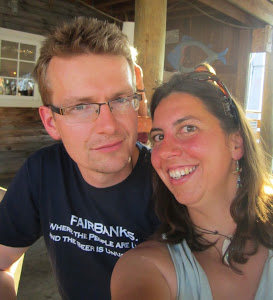Two Adventurers Recording Data as they Backpack Through Argentina and Chile
https://2enroute.blogspot.com/.
After 10 great days on Isla Navarino in southernmost Chile, I feel like I could write a book. However, because we head out into the mountains of Torres del Paine in 2 short hours, I will do my best to condense some of the most poignant thoughts and stories quickly (though perhaps not so concisely :).
Arriving by ferry and bumpy van ride in the small town (pop. 2000) of Puerto Williams on Jan. 17th, it felt like a world away from touristy Ushuaia just 50 km to the west. Kit-style houses and the buildings of a naval base are lined out along gravel streets where you are equally as likely to meet a grazing horse or a dog trotting down the street as you are to meet a person (and much more likely to see any of these than a vehicle driving by). Businesses are non-descript with small signs and shop-keepers who remembered us and greeted us with “Hola, Alaska!” when they saw us again. Walking around Puerto Williams our first day we were struck by its numerous similarities to a rural Alaskan village. Backyards were stacked with crab pots, equipment, and staked out dogs. Primary industries include tourism, fishing, shipping, the military, a scientific research station, and (historically) mining. The town is now the center of the indigenous Yaghan culture, where gatherings of Yaghan craftspeople and an excellent museum and cultural center seek to keep Yaghan language and cultural practices a part of the local landscape and community. But even more than these similarities, it was just the vibe of the village that really reminded Markus and I of parts of rural Alaska we have spent time in. People are personable, doors are open, and you easily find yourself in conversation or, as at our hostal Lajuwa, a part of family life. It is a place that seems arranged much more about living in place and in community than in manicured outward appearances of shiny storefronts and sharp work clothes. I loved being there and would love to return.
“It is a part of the Cabo de Hornos biosphere reserve and the people and the natural areas are vibrantly alive and wonderful to experience as a visitor… For our own part in the meantime, we collected some data on wildlife and land use for the Wildlands South America Biodiversity Inventory as volunteers through the organizationAdventurers and Scientists for Conservation”
Time to wrap up this post, but I will finish by saying just how blessed we feel to have visited and experienced the island. It is a part of the Cabo de Hornos biosphere reserve and the people and the natural areas are vibrantly alive and wonderful to experience as a visitor. There is still so much that is unknown about the area biologically, though the Omora park and research center on the island does a lot of research. For our own part in the meantime, we collected some data on wildlife and land use for the Wildlands South America Biodiversity Inventory as volunteers through the organizationAdventurers and Scientists for Conservation (more on that in a future post). I left thinking of Isla Navarino as a place I hope to return, whether for work or for a visit.
No time to post photos now, but come back again later and we hope to have some posted!
Retrieved from https://2enroute.blogspot.com/ on 1/31/2013

